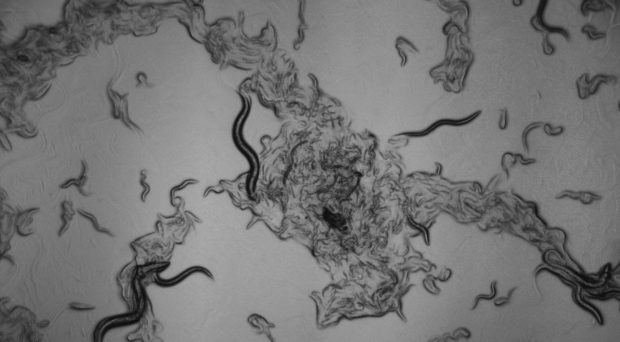
Only now is it becoming clear that these animals have a complex and fascinating sensory biology
Shakespeare tells us that “If music be the food of love, play on” – well for some animals it’s not music but smell. Many animals famously attract mates using chemical smells – called pheromones – typically secreted in sweat and urine. An intriguing example of this smelly communication is being slowly uncovered in the often unnoticed world of mouldy apples and rotten plant detritus, the home of the nematode roundworm, C. elegans. By peering into the natural biology of these places, we’re finding that these worms live in a complex world where smells carry detailed information about worms – their sex, how well fed they are, perhaps their genetics. These places are filled with public information broadcasts, but all done by smell.
The C. elegans worm has long been some scientists’ favourite system for the study of genetics and developmental biology. But only now is it becoming clear that these animals have a complex and fascinating sensory biology. It has long been known that in poor quality, crowded environments worms may be found as a non-feeding, long lived form called a dauer larva – something almost akin to hibernation. Immature larval worms may, instead of continuing to grow towards adulthood, choose to developmentally arrest as a dauer larva. A pheromone produced by worms is used by individuals to decide whether or not to become a dauer larva.
Since the 2000s, the chemical composition of the pheromone has been discovered, showing that it’s a complex modular system of hundreds of different pheromone molecules. Despite C. elegans having a limited repertoire of sensory neurons, worms are able to distinguish among chemically similar pheromone molecules.

Beyond the dauer larva decision, it’s becoming increasingly clear that this pheromone also affects a diverse set of other worm behaviours, including mate attraction, social aggregation, repulsion, and ageing. In our recent BMC Evolutionary Biology paper we show how pheromone alters worm reproduction and development. Specifically, when worms sense pheromone, they accelerate their reproduction, growth and development rates. This means that a worm’s olfaction is having significant effects on its biology, and so probably its fitness.
Worms may be using pheromone-based signals to trick each other
We also looked at worms from different genetic backgrounds – and this is when it starts to get really weird. We found that worms differ in the potency of their pheromone, measured as the effects that it has on other worms. Genetically different worms live together in the same locations, where their pheromones seem to have different effects on each other’s reproduction. When coupled with our previous work, showing a similar diversity of pheromone effects on larval arrest, the idea of a smell-based war among worms seems ever more real. Our bigger idea is that co-existing, but genetically different, worms may be using pheromone-based signals to trick each other into arresting as dauer when they shouldn’t, or into reproducing when they otherwise wouldn’t, all as ways to compete with each other.
To properly understand the true biological functions of this system of smells and behaviours we need to use whole new approaches to studying these worms, particularly studying them in the wild, rather than in the lab. If smell is indeed the food of love for these creatures then we can gain a fascinating insight into the minutiae of their personal lives, their biology, and their evolution by decoding their secret language of smell.
Comments